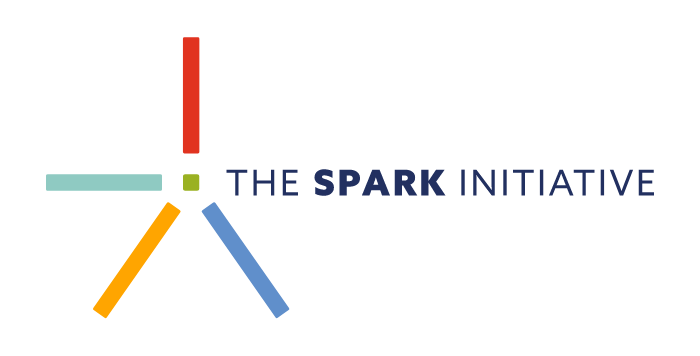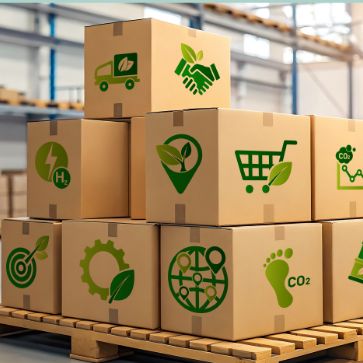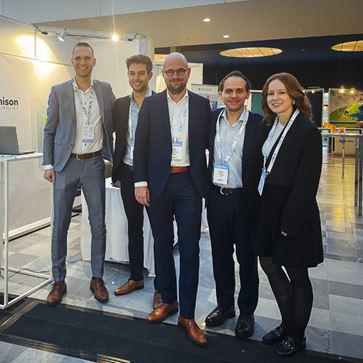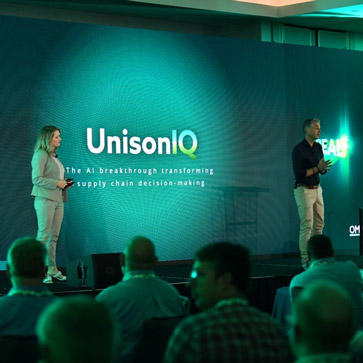
The risk of inaction: lessons from LogiChem 2023
Paul Delbar - April 7, 2023

This year’s excellent and vibrant LogiChem 2023 event confirmed its reputation as the place to connect with key players in the chemicals industry and discover what is driving their corporate and supply chain agendas.
It was the perfect opportunity for the OMP team to catch up with customers. Our booth was buzzing with activity as we conducted a quick survey, asking attendees to share their biggest business challenges. But before I reveal the top challenges, let's take a moment to highlight some of the key takeaways from the sessions and break-time conversations.
ROI: the Risk of Inaction
In his opening keynote, Dupont’s Pierrick Le Gallo set the stage for a lively event by redefining ROI as Risk of Inaction. And when it comes to taking action, Dupont knows what they’re talking about. The merger of Dupont and Dow in 2017, followed by the separation into Dow, Dupont and Corteva in 2019 completed an impressive business transformation. Rethinking and redesigning the supply chain to support this future vision was not without challenges, but also created opportunities to streamline processes and bring about organizational change which would have been hard or impossible in a normal, evolutionary way.
According to the survey we took at our booth, 58% of respondents are looking to change their supply chain processes to enable better planning. Radical transformations such as the one Dupont and Dow executed may not be within reach for everyone, but they can inspire a valuable thought experiment for many companies. If you could redesign all your business processes and break down departmental silos, what would you change? What would be the potential business value of such a change? And can you afford not to do it, and let inaction keep you from facing tomorrow’s challenges?
Towards sustainability… but how and when?
As expected, sustainability was a common topic across sessions. It was refreshing to see that LogiChem succeeded in selecting speakers and panelists who discussed sustainability from very different angles, providing the audience with new and interesting insights.
Blog post

EY’s Marc Hetzer pointed out the importance of procurement, given that up to 2/3 of a chemical company’s ESG footprint comes from suppliers (or other scope 3 contributors). As a result, any significant footprint reduction must involve a greener supply to make production more sustainable and to drive product innovation. But while the cost of greener products can be 30-40% higher than for equivalent ‘less-sustainable’ products, market research indicates that customers are only willing to pay a 10-15% premium.
Arkema’s Justin Lanyon suggested that companies should absorb the cost difference to keep (or grow) their market share. In 10-15 years, sustainability will no longer be a differentiator but rather a license to operate. Given the long lead times to develop new sustainable products, the time to act is now.
Blog post
Top challenges faced by chemicals companies today
It's not easy being green
So how are companies progressing toward their sustainability objectives? The industry has clearly moved past setting targets of reaching carbon-neutrality by 2040 or reducing the footprint by 50% by 2030. Today, companies are rather worrying about how to get there. Developing a sustainability roadmap turns out to be harder than expected. Measuring (and reporting) the current footprint and estimating the possible impact of new initiatives rest upon selecting a reference framework against which to measure and report.
Blog post
Companies are looking to various reporting directives such as the EU’s Corporate Sustainability Reporting Directive (CSRD) for guidance, while also feeling a mounting pressure to be compliant. With the majority of the footprint resulting from raw materials, it is no surprise that procurement teams are willing to pay a premium for sustainable materials that come with sustainability certification and are requiring suppliers to provide the necessary scope 3 reporting. Similarly, logistics and warehousing providers are likely to see increased pressure to report progress and implement initiatives towards reducing their footprint.
While these initiatives will help companies build a realistic road map towards their sustainability goal, it will also provide an objective basis for legal discussions with authorities or shareholders in case the lofty goals are not reached in time. The European Commission’s Green Claims Directive and similar global initiatives to force companies make hard on their public sustainability claims are making legal and compliance departments very nervous indeed.

Blog post
Pity the planner or not?
Meanwhile, companies continue to implement various sustainability initiatives, many of which send shockwaves through the supply chain planning process. From alternative sourcing to more sustainable materials and packaging, planners are challenged to optimize their plans within an ever-changing landscape.
Blog post

In our business challenge survey at LogiChem, 56% of respondents mentioned the need to bring sustainability objectives into the planning process, at par with the need to keep inventory levels under control and maintain margins in the light of cost fluctuations. Planners must now optimize a broader set of KPIs, including carbon emissions, wastewater usage, and energy consumption. Companies are starting to consider the impact of short-term disruptions, overtime and night shift usage on employee wellbeing as an important component of their ESG strategy.
Blog post
As a result, planners need to wear an increasing number of hats. At our 2022 OMP Conference, Land O’Lakes’ Dustin Braun commented: “I do think that planners’ jobs are going to become exponentially more complex with ESG trade-offs, not only emissions but social trade-offs as well. And so their lives are going to become much, much harder: a lot more decisions, a lot more complex decisions.”
Blog post
A different way of planning
How should companies (re)organize their supply chain teams and processes to support this evolution? In one of the panel discussions, the consensus was that companies need to ensure their planners have visibility into the end-to-end supply chain and should be equipped with the technology to make sense of the resulting data. Yet, the panelists had tried different strategies to achieve that goal.
Henkel’s Bjoern Kirchner explained how they extended their planners’ scope of control by upgrading demand planners to business planners, integrating them in business units and bringing raw material planners into the supply chain team for increased collaboration. According to Solvay’s Nese Sengezer, it’s also important to move the overall supply chain’s perspective from volume focus to a value focus. Dow’s Dobromir Likov agrees, stressing the need to manage the value chain across all horizons. Dow also moved planning from single-factory level to an integrated supply chain organization.
These evolutions are likely to transform the planner’s role significantly. More and more, planning decisions will focus on optimizing the business rather than individual plants or markets. Supply chain planning is becoming more collaborative, involving actors from procurement to marketing and sales in making decisions based and selecting the best scenario. As the participants in OMP’s Spark Initiative discovered during outside-in planning training, this transformation is likely to require a lot of organizational and process change.
For planners, this new type of supply chain organization provides an opportunity to move from the back room into the boardroom and increasingly weigh in on business decisions. To do that, they will need a unified planning platform incorporating all relevant data into a digital supply chain twin capable of assessing the impact of business choices and external disruptions. The planner will be the key actor to enable these redesigned collaborative planning processes and to create reality-based plans that deliver true business value.
Ready for the challenge
After three days of sharing, learning and networking, we’re going to miss LogiChem’s bristling atmosphere (and some of Rotterdam’s nightlife). We’ll bridge the long wait until next year’s LogiChem event by turning green and sustainable planning into a reality with our customers!
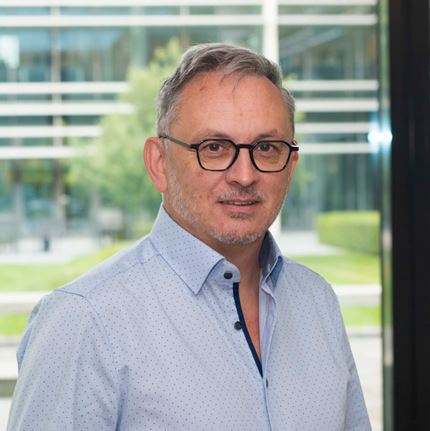
Paul Delbar
Senior Marketing Manager at OMP BE
Biography
Paul spent most of his career in software development, product management and marketing and enjoys using technology to bring solutions to customers. No stranger to supply chain planning and cross-enterprise collaboration, he is always interested in hearing your story and sharing it with the OMP Community.
